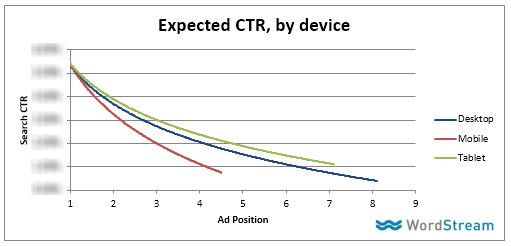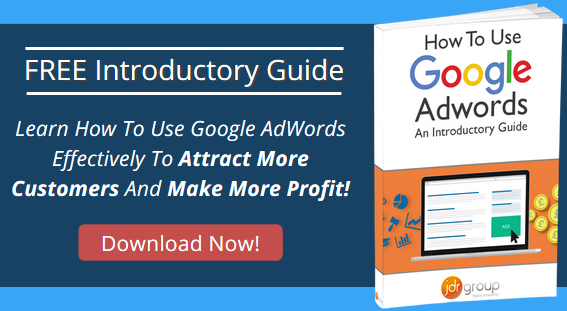Adwords’ New Mobile Ad Format: What It Means For You
by Daniel Baker on 06-Nov-2014 08:30:00

As a Google Adwords PPC advertiser, you are probably aware that maintaining a high ranking in the search results isn’t plain sailing. It’s in Google’s interest to continuously change their algorithms and rules to result in more relevant, compelling PPC ads. But it’s definitely worth your while keeping up with these changes, as you will be rewarded with more clicks, higher CTR, Quality Score and impression share. So what has Google announced this time? As of September, mobile PPC ads will have a new format; ads displayed on mobile devices will replace the second line of text with ad extensions.
How The New Mobile Ad Format Works
To give you an idea of how the new mobile ad format will look in the SERPs, here is a comparison for you: 
You will notice that by removing the second text line, you are making the new ad more links-based. Google says this is to optimise the user experience when searching on a mobile device; making it easy for them to click and interact with your ad.
For example:
In the new mobile ad above, the user can do 4 things to find out more about the business. They can click on the ad and go to a landing page, see current offers, go direct to ordering online or get directions to the shop.
Not only will you get more traffic to your website with this new format, your searchers’ level of engagement will increase and make them more likely to enquire or buy!
However, there is a slight catch. Because Google decides on how ad extensions will appear in the PPC SERPs, you can’t guarantee that they will show all your extensions 100% of the time. Often they will only show one of your ad extensions and sometimes even none of them. If the latter happens, your ad could appear as just 2 lines: a headline and one description line, with blank space underneath. This could be due to Google wanting to fit more PPC ads at the top of mobile search engines; leaving room for more ads that will bring more clicks and money in their pockets.
Having more mobile optimised PPC ads at the top of the rankings will also encourage advertisers to bid more fiercely by increasing competition. Wordstream released the graph below, which perfectly illustrates the impact of ad position on CTR: 
Benefits To PPC advertisers
You might think that the reasons behind the new mobile ad format are largely in Google's interests, so here's a summary of the benefits to you - the PPC advertiser.
1. Higher CTR -
Ad extensions are known for boosting the CTR of any PPC advert, especially on mobile devices. Consumers who are on-the-move can easily find the information they need by clicking on direct links - all in one ad. They also suggest that the business is credible and helpful.
2. More website traffic -
Naturally, with higher CTR comes more PPC traffic to your website. Having useful ad extensions, such as links to certain pages on your site, also means that this traffic will be better targeted and likely to engage with you - straight away or in the future.
3. Higher SERP ranking -
As I said earlier, Google has added 'expected impact of ad extensions' to the Ad Ranking calculation. So make sure you include relevant ad extensions to give your ads much better visibility on mobile devices. The exclusion of the second line of ad text under the new mobile format also leaves more space for you to climb up the rankings.
Want to find out more about some of the main ad extension types you can use? Read more about them here: Google Adwords Extensions: A Guide for Marketing Managers
How To Make The New Format Work For YOU
So now you have the background knowledge and know the benefits, here's the most important part; how you can harness the new mobile ad format and use it to get more leads and conversions.
1. Write mobile ads that are summarised in 1 line -
Every word counts when it comes to writing compelling ads - now more than ever. Revisit your mobile optimised ads and write all the most important, attention-grabbing copy in the headline and first description line. This means your ads will still have an impact even though the last line might not be visible.
2. Include a few ad extensions -
Set up at least 3 ad extensions to ensure that, if your second ad line is removed, you have a good variety of useful ways for searchers to engage with your ad. Not setting them up will result in you losing a line of precious advertising space - bad news for your ad ranking, CTR and impression share.
3. Tick the mobile-preferred ad option -
Do you already have regular desktop ads and want to edit them to comply with the new mobile ad format? Whenever you create a new ad, it gives you the option for it to be 'mobile-preferred'. Just create a new text ad and a copy of your desktop ad will appear, which you can adjust to keep the main message succinctly in the first line. Tick the 'mobile-preferred' box underneath and you now have a mobile device optimised ad.
4. Keep on split-testing -
To enhance your CTR and ad ranking further with the new mobile ad format, it's a smart idea to run regular split tests. Experiment with different wordings of the first line of ad text and even your use of ad extensions. For example, writing different sitelink descriptions. This testing process will allow you to hone your mobile PPC ads and stay ahead of your competitors.
This whole article goes to show how a small change to one type of Adwords PPC ad can have a huge influence on the effectiveness of your advertising. Follow these recommendations of how to get the most out of the new format of mobile ads to stay in favour with Google, improve ad ranking, impression share and CTR.
Article by Laura Wootton
- Inbound Marketing (SEO, PPC, Social Media, Video) (824)
- Strategy (363)
- Sales & CRM (195)
- Marketing Automation & Email Marketing (190)
- Business Growth (164)
- Website Design (160)
- Hubspot (138)
- Lead Generation (115)
- Google Adwords (98)
- Content Marketing (94)
- Conversion (48)
- Case Studies (47)
- News (47)
- Ecommerce (39)
- Webinars (34)
- SEO (24)
- AI (20)
- Events (19)
- Video (17)
- LinkedIn Advertising (15)
- Video Selling (15)
- Software training (13)
- Niche business marketing (11)
- The Digital Prosperity Podcast (10)
- Facebook Advertising (6)
- HubSpot Case Studies (5)
- December 2025 (10)
- November 2025 (6)
- October 2025 (17)
- September 2025 (16)
- August 2025 (14)
- July 2025 (14)
- June 2025 (5)
- May 2025 (19)
- April 2025 (15)
- March 2025 (13)
- February 2025 (13)
- January 2025 (8)
- December 2024 (2)
- November 2024 (4)
- October 2024 (21)
- September 2024 (4)
- August 2024 (8)
- July 2024 (14)
- June 2024 (16)
- May 2024 (25)
- April 2024 (15)
- March 2024 (18)
- February 2024 (5)
- January 2024 (10)
- December 2023 (6)
- November 2023 (10)
- October 2023 (13)
- September 2023 (12)
- August 2023 (14)
- July 2023 (13)
- June 2023 (14)
- May 2023 (15)
- April 2023 (13)
- March 2023 (14)
- February 2023 (13)
- January 2023 (15)
- December 2022 (13)
- November 2022 (6)
- October 2022 (8)
- September 2022 (22)
- August 2022 (15)
- July 2022 (13)
- June 2022 (16)
- May 2022 (14)
- April 2022 (16)
- March 2022 (17)
- February 2022 (11)
- January 2022 (8)
- December 2021 (6)
- November 2021 (7)
- October 2021 (11)
- September 2021 (10)
- August 2021 (7)
- July 2021 (7)
- June 2021 (4)
- May 2021 (4)
- April 2021 (1)
- March 2021 (3)
- February 2021 (5)
- January 2021 (4)
- December 2020 (7)
- November 2020 (6)
- October 2020 (5)
- September 2020 (9)
- August 2020 (18)
- July 2020 (17)
- June 2020 (17)
- May 2020 (10)
- April 2020 (21)
- March 2020 (24)
- February 2020 (21)
- January 2020 (12)
- December 2019 (23)
- November 2019 (12)
- October 2019 (14)
- September 2019 (16)
- August 2019 (15)
- July 2019 (13)
- June 2019 (6)
- May 2019 (8)
- April 2019 (4)
- March 2019 (2)
- February 2019 (2)
- January 2019 (2)
- December 2018 (3)
- November 2018 (24)
- September 2018 (11)
- August 2018 (9)
- June 2018 (3)
- May 2018 (6)
- April 2018 (14)
- March 2018 (12)
- February 2018 (16)
- January 2018 (15)
- December 2017 (15)
- November 2017 (18)
- October 2017 (23)
- September 2017 (19)
- August 2017 (28)
- July 2017 (27)
- June 2017 (25)
- May 2017 (18)
- April 2017 (17)
- March 2017 (16)
- February 2017 (17)
- January 2017 (14)
- December 2016 (21)
- November 2016 (27)
- October 2016 (25)
- September 2016 (16)
- August 2016 (20)
- July 2016 (19)
- June 2016 (14)
- May 2016 (20)
- April 2016 (24)
- March 2016 (22)
- February 2016 (28)
- January 2016 (27)
- December 2015 (28)
- November 2015 (19)
- October 2015 (9)
- September 2015 (12)
- August 2015 (5)
- July 2015 (1)
- June 2015 (10)
- May 2015 (3)
- April 2015 (11)
- March 2015 (14)
- February 2015 (15)
- January 2015 (12)
- December 2014 (2)
- November 2014 (23)
- October 2014 (2)
- September 2014 (2)
- August 2014 (2)
- July 2014 (2)
- June 2014 (7)
- May 2014 (14)
- April 2014 (14)
- March 2014 (7)
- February 2014 (2)
- January 2014 (7)
- December 2013 (9)
- November 2013 (14)
- October 2013 (17)
- September 2013 (3)
- August 2013 (6)
- July 2013 (8)
- June 2013 (4)
- May 2013 (3)
- April 2013 (6)
- March 2013 (6)
- February 2013 (7)
- January 2013 (5)
- December 2012 (3)
- November 2012 (2)
- September 2012 (1)
Subscribe by email
You May Also Like
These Related Blogs

Google Adwords Cost - A Quick Guide to How it Works
Do you currently use traditional forms of advertising to promote your business message, but want something cheaper? Do you long for a less time-consum …

Not Targeting The Right Type Of Customers Online? How Google AdWords Targeting Can Help
Google AdWords is a multi-faceted tool that can help to define your business’ core customers and clientele. As many company directors and marketing ma …

Google AdWords Keyword Match Types – How To Save Money & Get Better Results
Google AdWords keyword match types tell Google how you want it to match your ads to keyword searches – whether you want to be restrictive or show your …



